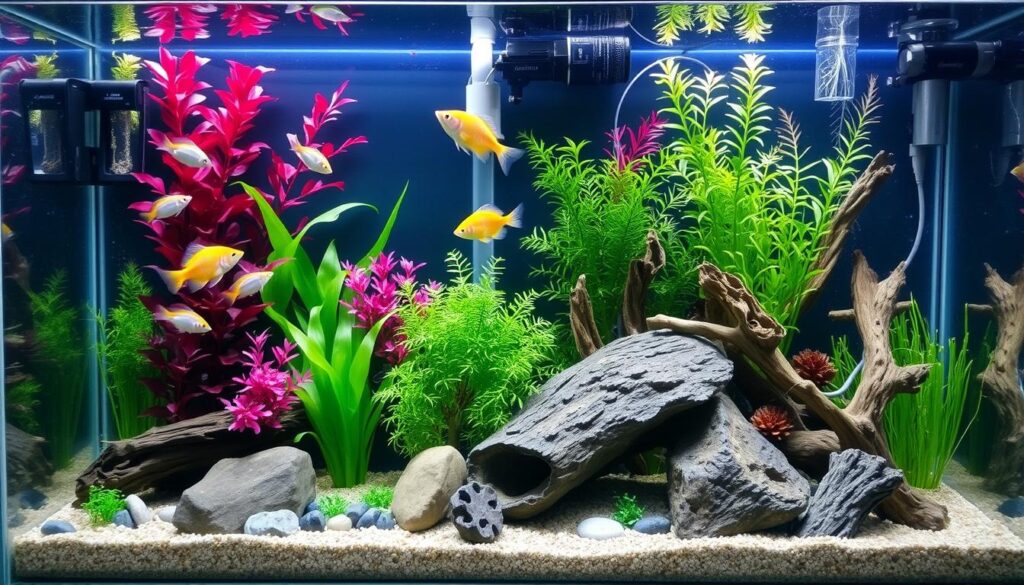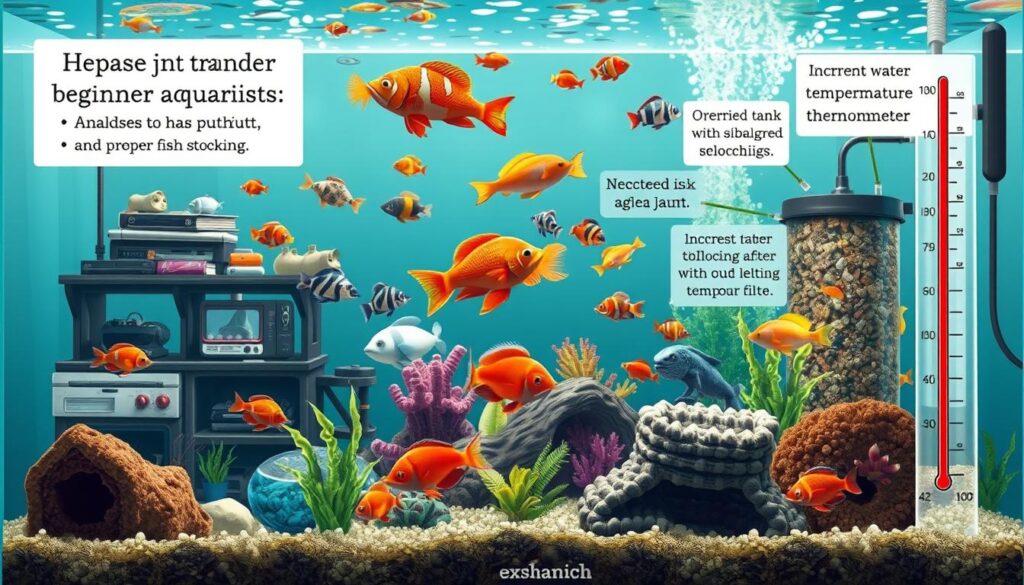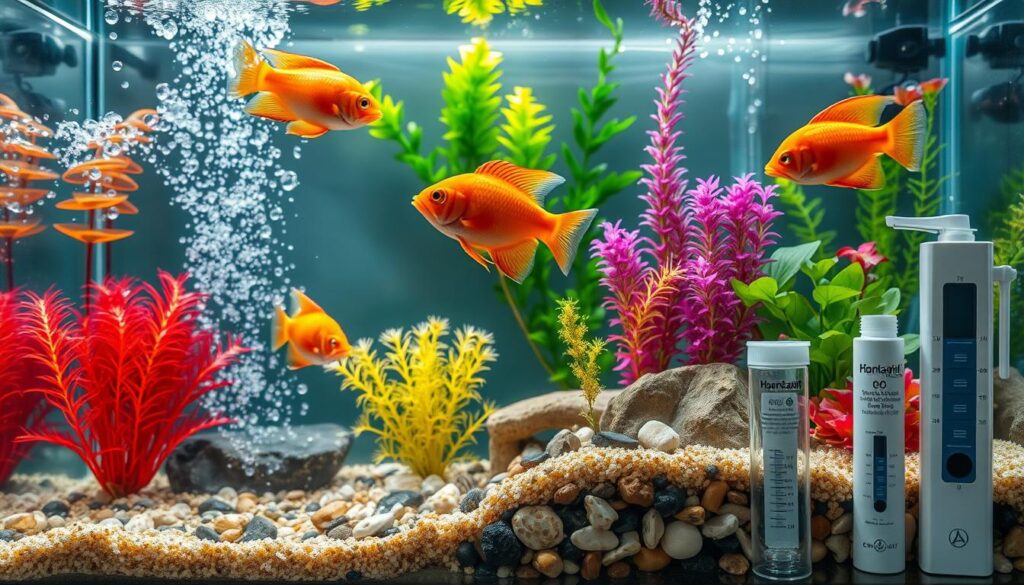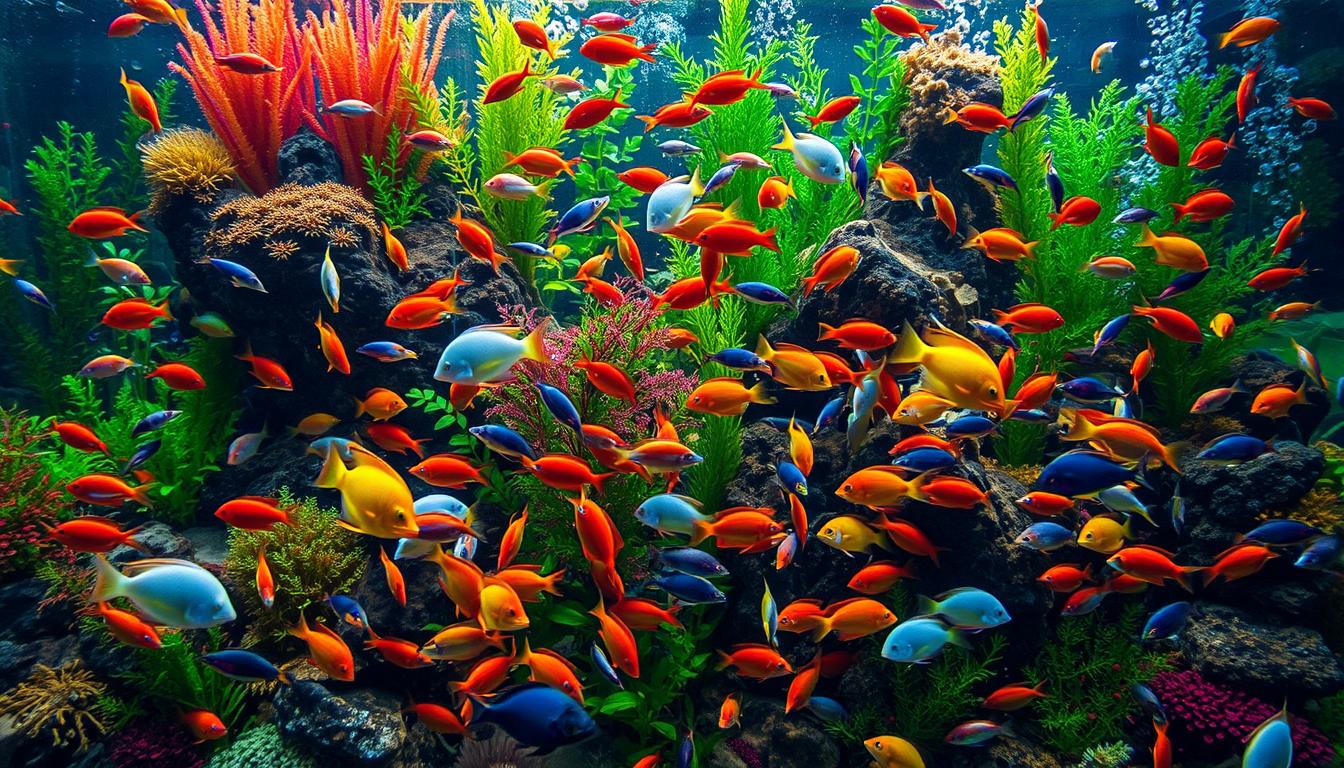Starting an aquarium is exciting and rewarding for new enthusiasts. But it’s easy to hit roadblocks along the way. Knowing the common mistakes can help you avoid frustration and setbacks. In this article, we’ll cover the top five mistakes beginners make and offer tips for a healthy tank.

Key Takeaways
- Understand the importance of the aquarium cycling process before introducing fish
- Avoid the common mistake of overfeeding your aquatic pets
- Learn how to properly manage water quality and tank stocking levels
- Recognize the signs of an overcrowded tank and take corrective action
- Develop a routine for regular water testing and maintenance to keep your aquarium thriving
Understanding the Aquarium Cycling Process: Your First Critical Step
Creating a healthy cycling aquarium is key to success in aquarium keeping. The cycling process is vital but often not well understood. It prepares the tank for a lively underwater world.
At the core of this process is the nitrogen cycle. It’s a complex series of steps that makes the tank stable and balanced.
The Nitrogen Cycle Explained
The nitrogen cycle is a balance between bacteria, fish waste, and the breakdown of harmful compounds. Fish release ammonia, which bacteria like Nitrosomonas turn into nitrite. Then, Nitrobacter bacteria change nitrite into nitrate, making the water safe for fish.
Testing Water Parameters
It’s crucial to check water parameters during the cycling tank phase. Regular water quality testing helps you see how ammonia, nitrite, and nitrate levels change. This ensures the cycle is working right.
By watching these levels closely and making adjustments, you can prevent problems. This keeps your aquarium healthy.
Cycling Timeline and Patience
The cycling aquarium process can take weeks to months. It depends on tank size, fish numbers, and live plants. Patience is essential during this time.
Rushing the cycle can harm your tank. With careful water quality testing and maintenance, your tank will become a thriving home for fish and plants.
Learning about the cycling aquarium process is the first step to a successful aquarium. By understanding the nitrogen cycle, monitoring water parameters, and being patient, you’ll create a vibrant and healthy underwater world.
Top 5 Mistakes Beginners Make When Starting an Aquarium
Starting an aquarium can be a fun and rewarding hobby. But, it comes with its own set of challenges. As a beginner, you might make a few mistakes. We’ll look at the top five mistakes beginners often make and how to avoid them.
- Lack of Research: Many beginners dive into fish ownership without learning about the care needed. Not researching the needs of your fish can lead to disappointment and poor tank health.
- Rushing the Nitrogen Cycle: The nitrogen cycle is key to a healthy aquarium. Skipping or rushing this step can harm your fish.
- Overfeeding: Overfeeding can cause water quality issues and harm your fish. It’s important to follow a proper feeding schedule and choose the right food.
- Overstocking: Putting too many fish in a small tank can stress them out. It also increases the risk of disease and water problems.
- Neglecting Water Quality: Good water management is vital for your fish’s health. This includes regular testing, water changes, and keeping chemical levels balanced.
By knowing these common mistakes and learning about fish care, you can make your aquarium a success. Enjoy the journey of fishkeeping.

Overfeeding and Its Devastating Effects on Tank Health
As beginner aquarium enthusiasts, it’s easy to overfeed our fish. It might seem like we’re helping them, but it can harm our tank’s health.
Signs of Overfeeding
Knowing the signs of overfeeding is key. Look for cloudy water, too much algae, and fish that seem sick or tired. Too much food also means more waste, which can hurt water quality.
Proper Feeding Schedule
Keeping your tank healthy means a good feeding schedule. Feed your fish just enough for them to eat in 2-3 minutes, 2-3 times a day. Don’t overfeed, as it can upset your tank’s balance.
Food Selection Guidelines
- Choose high-quality, species-appropriate fish food that is tailored to the dietary needs of your fish.
- Vary the diet by incorporating different types of food, such as flakes, pellets, and frozen or freeze-dried options.
- Avoid feeding your fish human food, as it can be difficult for them to digest and may lead to health issues.
By spotting overfeeding signs, following a good feeding schedule, and picking the right food, you can keep your tank healthy. A balanced tank is vital for your fish’s happiness and health.

The Hidden Dangers of Overstocking Your Tank
Starting your aquarium journey can be thrilling. It’s tempting to add more fish. But, overcrowding the fish can harm their health. It’s important to know the risks of overstocking your aquarium to keep your fish happy and healthy.
When you overstock, fish fight for food, oxygen, and places to hide. This stress can make them aggressive and spread diseases. Also, some fish species may not get along, leading to injuries or death.
Overstocking also puts too much pressure on your tank’s filters. This can lead to bad water quality. Bad water quality harms your fish’s health.
Guidelines for Responsible Stocking
- Research the fish compatibility and size before adding them.
- Follow the recommended stocking density for your tank size.
- Add new fish slowly to let the tank adjust.
- Keep an eye on water quality and change it regularly.
| Tank Size | Recommended Stocking Density |
|---|---|
| 10 gallons | 1-2 small fish |
| 20 gallons | 3-5 small fish |
| 30 gallons | 5-7 small fish |
| 50 gallons | 8-10 small fish |
By knowing the hidden dangers of overstocking and following guidelines, you can keep your fish healthy and happy for a long time.

“The key to a thriving aquarium is not how many fish you can fit, but how well you can care for them.”
Essential Water Quality Management Tips
Keeping your aquarium water quality right is key for your fish and plants’ health. To keep your tank a lively home, follow these important tips for water quality management.
Regular Testing Schedule
Testing your water regularly is the first step in managing water quality. Set up a schedule to check pH, ammonia, nitrites, and nitrates. This way, you can spot and fix any issues before they harm your fish.
Water Change Best Practices
Changing your tank’s water is a crucial part of aquarium care. Try to change 25-50% of the water each week. This refreshes the water and keeps it clean. Always use a dechlorinator to make the new water safe for your fish.
Understanding Chemical Balance
It’s important to keep the right chemical balance in your tank. Watch the pH, alkalinity, and hardness levels closely. Adjust them as needed to make a great home for your live plants and fish. A good aquarium filtration system also helps keep the balance.

By following these tips, you can make sure your aquarium stays healthy and vibrant. Your aquatic life will thank you for years to come.
Conclusion
Starting your aquarium journey is exciting. But, it’s important to avoid common mistakes. Learning about the aquarium cycling process and managing water quality is key. These steps help create a beautiful underwater world.
Understanding the nitrogen cycle and testing water regularly are crucial. Following proper feeding and tank maintenance will help you succeed. Don’t forget to explore aquatic plants and aquarium lighting to make your tank look great.
With patience and a willingness to learn, you can avoid common mistakes. This will help you create a vibrant and healthy aquarium. Enjoy the journey and let your aquarium be a source of inspiration every day.
FAQ
What are the most common mistakes beginners make when starting an aquarium?
Beginners often make a few big mistakes. They overfeed their fish and put too many fish in the tank. They also skip the aquarium cycling process and don’t manage water quality well. Plus, they don’t research which fish can live together.
Why is the aquarium cycling process so important?
The cycling process is key because it sets up the nitrogen cycle. This cycle turns bad stuff like ammonia and nitrite into safer nitrate. It makes sure your tank is ready for fish, keeping the water and fish healthy.
How do I avoid overfeeding my fish?
To not overfeed, give your fish just what they can eat in 2-3 minutes, 2-3 times a day. Know the right food and how much for your fish. Too much food can make the water bad, harm your fish, and cause algae.
What are the dangers of overstocking my aquarium?
Too many fish in your tank can cause problems. It leads to overcrowding, fights, and water quality issues. Make sure you know how many fish your tank can handle and choose compatible fish.
How can I maintain good water quality in my aquarium?
Keep your water quality up by testing it often and changing some water regularly. Good filtration, live plants, and knowing the chemical balance are also important. This keeps your aquarium water healthy and your fish happy.




 No products in the cart.
No products in the cart.